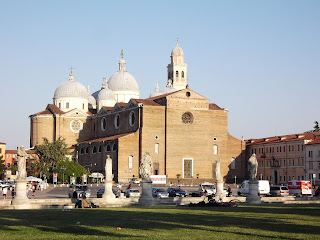 |
| Giustina, in a painting here by Bartolomeo Montagna, hailed from a noble family |
She was a victim of the purge of Christians undertaken by the Emperor Diocletian, the last major attempt to stamp out what was regarded by the Romans as a subversive cult.
He was carrying out an edict that rescinded all legal rights for Christians and compelled Christians to sacrifice to Roman gods or face imprisonment or execution.
What became known as the Diocletian Persecution concentrated first on purging the Roman military of Christians and then broadened to the population in general.
When Diocletian's officers confronted Giustina in Padova, they ordered her to go to the Roman temple to Minerva to worship the Roman goddess, offer her virginity as sacrifice and renounce Christianity.
Because she refused to do so and denounced the Roman gods, Giustina was condemned to death. The execution is said to have taken place at Pontecorvo, where she was stabbed through the heart with a sword.
 |
| The vast Basilica di Santa Giustina overlooks Prato della Valle, one of Padova's main squares |
It came too late for Giustina, whose body was buried in a cemetery near what was then the Zairo Roman theatre and now lies beneath the altar table in the magnificent Basilica di Santa Giustina, with its eight domes, which was built the 16th century on the site of the cemetery.
The ninth largest Christian church in the world, the basilica houses the remains of many revered saints, including those of St Luke the Evangelist, who is credited with writing the Gospel According to St Luke.
Giustina is a patron saint of many other Italian municipalities in addition to Padova and a co-patron saint of Venice, where she became extremely popular for a number of years following the Battle of Lepanto in 1571.
This was a naval battle between a coalition of Catholic maritime states brought together by Pope Pius V and the Turkish fleet which took place on her feast day - October 7 - and which was decisive in halting the expansion of the Ottoman Empire on the European side of the Mediterranean.
The Basilica di Santa Giustina is situated at the south-east corner of the elliptical piazza known as Prato della Valle. Among many things worth seeing is a magnificent altarpiece painted by Paolo Veronese in 1575, depicting the moment of her death.
Next door to the basilica there is a Benedictine monastery with frescoed cloisters and a famous library that can be visited by arrangement. Admission to the basilica is free. It is open from 7.30am until noon and from 3pm until 6.30pm (7.30pm on Sundays).
 |
| Prato della Valle, built on the site of a former Roman theatre, is notable for its 78 statues of eminent citizens of Padova |
The nearby Ristorante Zairo contains statues and wall decorations that recall the chariot races and other activities that would have taken place in the theatre. Diners can also see a 17th century fresco that came to light when renovations uncovered part of the structure of a former church.
Home